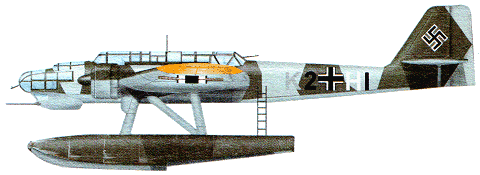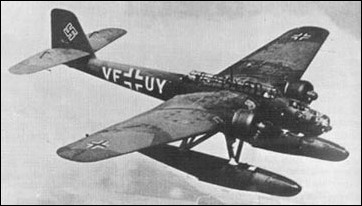|
| Developed to replace the He 59, the Heinkel He 115 floatplane prototype was flown during 1936. Its two machine-guns were then removed, their positions faired over, and on 30 March 1938 the aircraft set eight payload/speed records. The second prototype was similar, the third introduced the 'glasshouse' canopy which became standard, and the fourth was the production prototype with float/ fuselage bracing wires replaced by struts. The He 115s were used by coastal reconnaissance squadrons of the Luftwaffe, and after the outbreak of World War II were deployed to drop parachute mines in British waters. Four reached the UK from Norway, three being modified later for clandestine operations to Norway and the Mediterranean.

 | A three-view drawing (1000 x 712) |
| Barry, 07.08.2012 12:27 The coloured illustration shows the 'C' model which featured an MK151 20mm cannon under the nose. Production ceased in 1941 only to be reinstated in 1943 with the 'E' model. This was probably the best and most efficaceousd float plane employed by the Germans in the second world war.Total production including prototypes was some 500 units. In May 2012 an He115, 8L+FH, was raised from the sea near Stavanger and is one of only 2 known to be in existence the other being stored somewhere in France.
Power plant BMW 132
Span 72'2"
Length 56'9"
Height 21'8"
Weight empty 11,684lb
Max T /O weight 18,045lb reply | | gene, e-mail, 30.09.2011 18:28 The military channel did a great story on this...the German designers used every inch of the space available in the wing roots and floats to pack survival gear, repair parts, tools and supplies...very very innovative! reply | | loupan, 21.06.2011 06:25 wing for engine maintenance but nothing for dropped tools. Kerplunk. reply | | leo rudnicki, e-mail, 09.04.2009 06:20 There were seats which retracted into the wing for engine maintenance but nothing for dropped tools. Kerplunk. reply |
|
Do you have any comments?
|
| 
COMPANY
PROFILE
All the World's Rotorcraft
|








